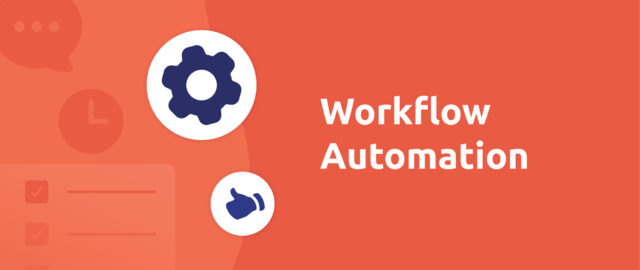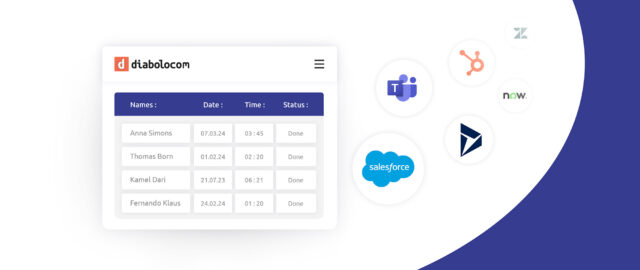Improve contact center efficiency with workflow automation
Automating workflows is an essential step in improving contact center efficiency, and therefore your customers’ experience. A wide range of processes can be automated with contact center software, from routing calls to the right agents, to data entry, to synchronizing information with the CRM.
At Diabolocom, the AI-enhanced CCaaS expert, we see the positive impact of workflow automation on our customers every day.
Find out in this article how to transform your contact center with workflow automation.
Workflow automation: a contact center need
Workflow automation refers to the use of technology to streamline and optimize repetitive operations in a contact center. By replacing manual interventions with automated solutions, to improve efficiency and accuracy.
It’s important to distinguish between workflow automation and task automation, even though the two terms can overlap. The former refers to processes, the latter to actions.
Automated workflows improve agent efficiency and productivity, meeting a strong need in contact centers.
Here are a few examples of workflow automation:
- Automatic routing of calls to the most qualified agent, reducing customer waiting time and improving the way requests are handled.
- Automatic categorization and assignment of customer tickets, again helping to improve response time and quality.
- Automatic reminder scheduling for agents, based on task urgency, customer preferences and company objectives.
- Automatic database updates following customer interaction.

Key automation tools and techniques
There are several tools and technologies available for automating your contact center workflows. Here are the main ones:
Intelligent routing of customer requests
Routing is the process of directing customer requests to the right people and the right skills. Intelligence routing is a technology that uses advanced algorithms to analyze incoming requests, taking into account criteria such as request content, language and urgency.
By identifying the agent or department best able to respond efficiently, automatic flow routing minimizes delays and ensures an optimized customer experience. This process adapts in real time to changes in workload. Diabolocom natively integrates an Automatic Call Distributor (ACD) that responds precisely to this challenge.
Automated data entry and analysis
Tech solutions exist to streamline the task of inputting customer data into CRM systems. Diabolocom provides an extensive array of connectors to make integrating computer-telephony (CTI) a breeze, enabling automatic transfer of information gathered during calls into your CRM, ERP, or other business tools.
You can then leverage analytics tools to sift through this data, generating detailed reports that offer insights to predict customer needs and refine your service strategy.
Tracking and automated notifications
Automated tracking and notification systems play a key role in customer communication. By sending proactive updates and reminders, they reinforce transparency and trust. This automation ensures a smoother customer experience, while at the same time reducing agents’ workload.
Self-care options
The integration of AI-based voicebots and interactive voice servers (IVR) gives customers the ability to solve common problems autonomously. These 24/7 self-service solutions, both natively integrated into Diabolocom software, improve accessibility and customer satisfaction, while enabling agents to concentrate on more complex requests.
Predictive analysis
Predictive analytics uses artificial intelligence to examine historical data and predict future customer behavior or needs.
By anticipating requests, contact centers can personalize their interactions and improve customer satisfaction. The use of predictive analytics helps optimize resources by targeting efforts where they are most needed.
Diabolocom offers several AI-based features for predictive analytics, including:
- Sentiment analysis, which detects customer irritants from voice and text.
- Next Best Action Detection, which deduces from call analysis the best next actions to take.
Automated e-mail management
Technology can be used to automatically process incoming e-mails, classifying, prioritizing and replying where possible. This ensures faster, more efficient e-mail management and reduces response times. Automated e-mail management also enables agents to concentrate on more strategic tasks.
Third-party systems integration
Automated integration between different systems simplifies the transfer of information and the updating of data in real time. We’re thinking here in particular of synchronization between contact center management software and CRM software.
Integrating these systems reduces manual errors, increases efficiency and provides a unified view of the customer across different platforms. Diabolocom offers integrations with the market’s leading CRM systems, including Salesforce, Zendesk, Microsoft Dynamics, Oracle and Service Now.
Benefits of workflow automation
Here are the main benefits of automating contact center workflows:
- Reduce manual tasks: Automation eliminates the need for agents to perform repetitive, time-consuming tasks. By automating data entry and ticket categorization, for example, agents can devote more time to solving complex problems.
- Minimizing errors: By replacing manual processes with automation, contact centers ensure greater accuracy in processing requests. This accuracy leads to a significant reduction in human error.
- Increased agent productivity: With automation, agents can handle a higher volume of customer interactions without sacrificing service quality. With automation, quality and quantity go hand in hand. Automated workflows result in a greater ability to respond quickly to customer needs, and help improve overall contact center performance.
- Improved customer experience: Automation enables faster, more precise responses to customer queries, thereby helping to improve customer satisfaction, and hence the customer experience. In addition, automated analysis of customer feedback provides valuable insights for continuous improvement of service quality.
- Lower operational costs: Automation reduces the costs associated with manual management of repetitive tasks. The result is a reduced need for human resources for activities that can be automated.
- Flexibility and scalability: Automated solutions have the advantage of easily adapting to changing workloads, enabling contact centers to efficiently manage peaks in activity without compromising quality.
- Continuous improvement: Automation often incorporates learning and adaptation capabilities. In this way, workflow automation enables continuous optimization of processes in line with feedback and changing customer needs.
Implementing workflow automation: challenges and considerations
Implementing workflow automation in contact centers has great advantages, but it also comes with its share of challenges that it’s important to anticipate well. Here are the main challenges and considerations to bear in mind if you’re thinking of implementing workflow automation:
- Personalization versus automation: Striking the right balance between automation and human interaction requires a detailed understanding of customer needs and technology capabilities. Too much automation can damage the customer experience, while too little can reduce efficiency. It’s all about finding the right balance.
- Integration with existing systems: Effective integration of new automation tools with existing systems and databases is the key to a smooth transition and efficient operation. Without seamless integration, there could be gaps in data transmission affecting both productivity and the customer experience.
- Employee training and adaptation: The success of automation depends on employees’ ability to use new technologies effectively. Comprehensive training is essential to maximize the benefits of automation while minimizing resistance to change.
- Cost-benefit analysis: Weighing up the initial investment against the long-term benefits is essential. Automation must be economically viable, improving operational efficiency and making a positive contribution to customer experience and the bottom line. An estimate of the return on investment (ROI) should be carried out during the scoping phase of your workflow automation project.
- Data security and compliance: The introduction of automation tools can raise issues of data security and regulatory compliance. It is important to ensure that the solutions adopted comply with current standards for the protection of customer data (as is the case with Diabolocom).
- Maintenance and upgrades : Automation systems require regular maintenance and upgrades to remain safe and efficient. Planning these activities is essential to avoid service interruptions and ensure optimum performance.
- Resistance to change: Implementing new technologies can be met with resistance from employees accustomed to traditional methods. Your ability to manage change is crucial to the success of your transition to workflow automation.

Conclusion
A large number of workflows can be automated, helping to increase the efficiency and operational excellence of your contact center. If implemented wisely, automation can also help improve the customer experience.
At Diabolocom, we’re committed to supporting and assisting you in integrating workflow automation at the heart of your contact center operations. Numerous customers have already placed their trust in us, following the example of Bouygues Immobilier, whom we successfully supported in automating their contact center workflows.
Contact us to explore customized solutions that match your specific needs, and let’s work together for a more efficient, responsive and customer-focused contact center.
Curious to know more about Diabolocom?




